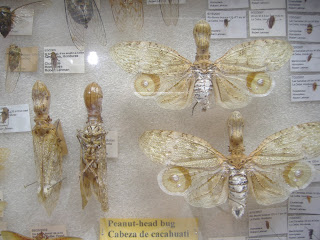
My favorite part of being in La Ceiba was going to El Museo de las Mariposas (The Butterfly Museum). A true DC girl spoiled by the Smithsonian Institute, I sniff out the museums anywhere I go, and I was excited to find something on natural history as well. The museum is run by an American ex-pat from Ohio who taught school for many years here in Honduras. He gives talks to school groups, and there are rumors of the 10th grade parents wanting to organize a trip to Ceiba... I might just get my students in there yet!
The museum wasn't just butterflies, and I learned quite a lot about central american and worldwide insects. One fascinating yet dangerous thing I learned about was the "kissing bug," in the assassin bug family that transmits a parasite responsible for Chagas disease.


Getting up close and personal with a live Hercules beetle :) Don't worry, they don't bite. He was happily sucking on a piece of papaya before we met.

There was also an insect unlike any I had ever seen before--the "peanut head bug." The elongated, lumpy part of its head is actually hollow, so essentially a predator could take a bite out of the insect's head with all its vital organs still intact.
I was also pleased to purchase lots of educational materials for the school there. I think it's important that the kids at our school learn more about what's available in their own country. Since it's a bilingual school, many of our textbooks are from North America and talk about things for which Hondurans don't have much context (one of my students asked me about fall and snow the other day). I thought it was GREAT that the butterfly museum had big color posters of different insects that were native to Honduras, and I bought a bunch of them. I also got a CD of birdcalls of Honduras and a CD-ROM of orchids of Honduras. It seems that folks are very familiar with the national symbols of Honduras (white-tailed deer, orchid, etc) but they don't seem to know much beyond that, so I think we will have fun learning about all this country has to offer together.

No comments:
Post a Comment